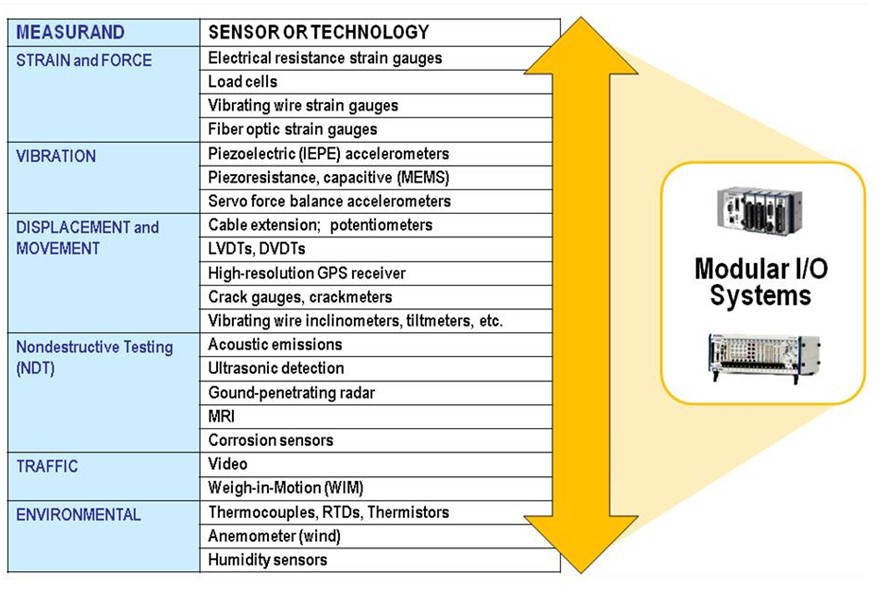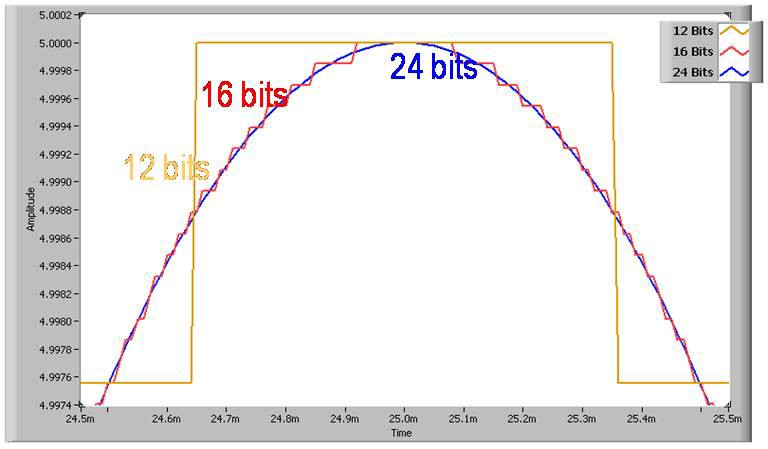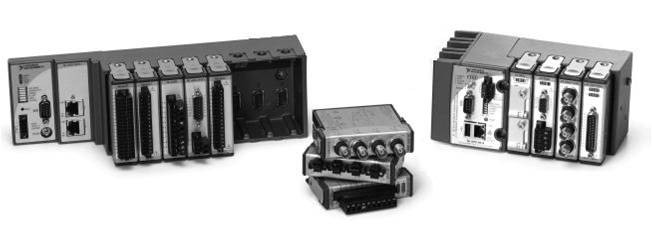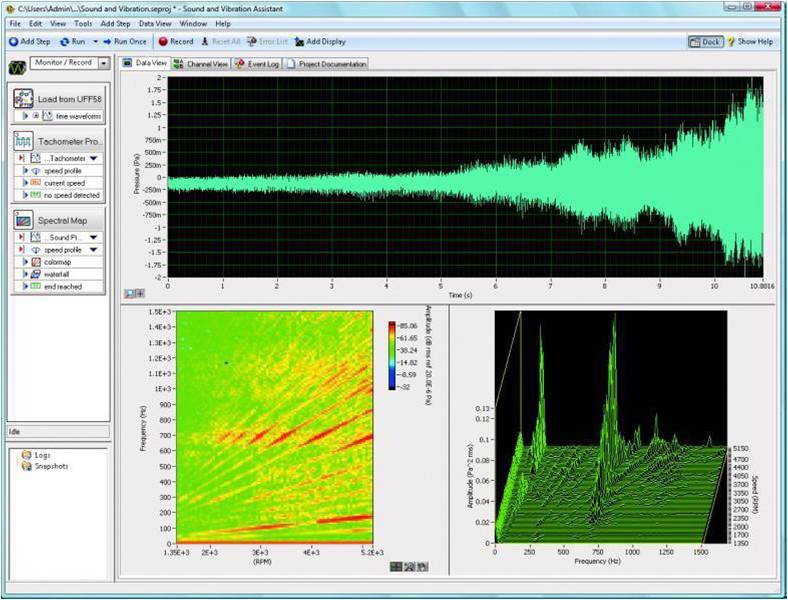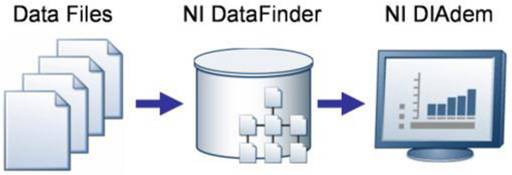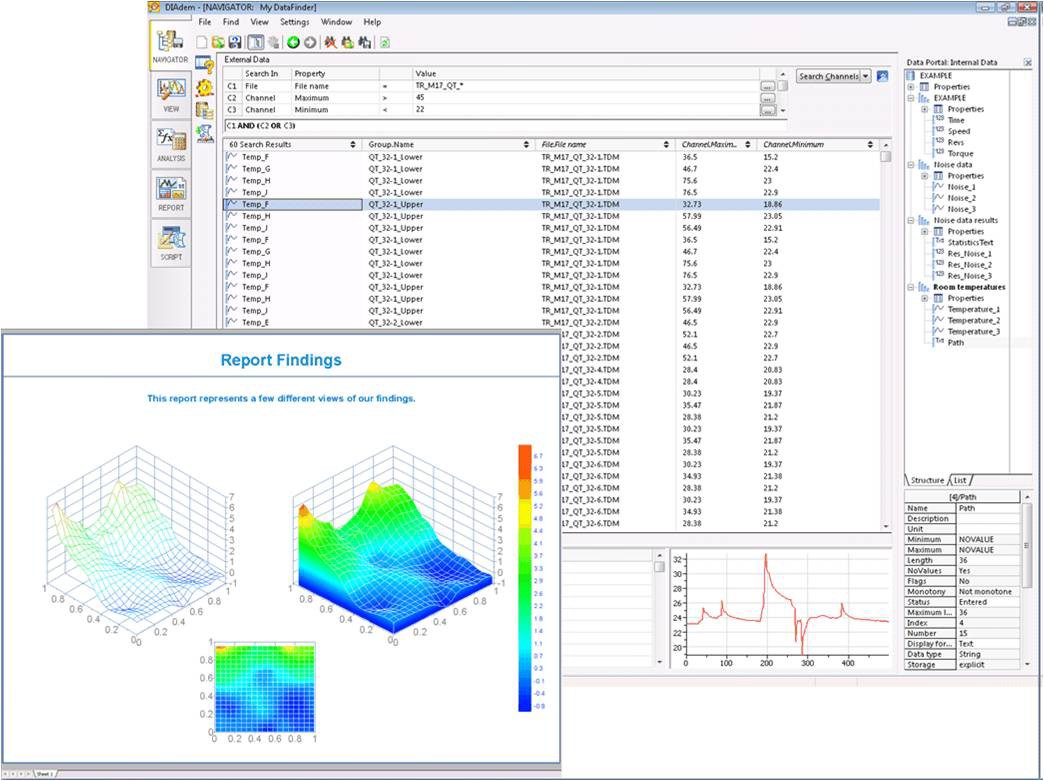New Technologies for Structural Testing and Health Monitoring
Overview
The safety, maintainability, and livability of the world's civil infrastructure depend on structural testing and structural health monitoring (SHM) applications. Typically short in duration, structural tests are implemented within the lab environment and need some kind of a stimulus signal. In contrast, structural health monitoring refers to continuous monitoring of structures in the field under natural operating conditions. Although this paper specifically focuses on SHM, these two application areas share several principles and technologies, and the concepts discussed in this paper are applicable to structural tests as well.
Contents
- Structural Health Monitoring
- Multimodal Sensor Systems
- Robust, Precision Signal Conditioning
- Distributed Measurement Systems
- Software Technologies
- Summary
Structural Health Monitoring
Structural health monitoring combines various physical sensing and measurement techniques with continuous, remote processing to capture real-time data, log it to a historical record, and continuously analyze it. Because of the size and complexity of the structures being monitored, you must be well-versed in multiple disciplines ranging from sensing techniques to multisystem synchronization to structural dynamics to data management and analysis and more. This paper examines four key technologies for structural testing and structural health monitoring and the ways NI incorporates them in its solutions.
- Multimodal sensor systems
- Robust, precision signal conditioning
- Distributed measurement systems
- Software technologies
Multimodal Sensor Systems
Sensor technology is one of the most active areas of structural testing and monitoring research and technological advancement. SHM systems integrate a variety of sensors, and sensor technology options continue to expand. Most SHM systems today use sensors such as strain gages, vibration or accelerometer sensors, and displacement sensors to track the stresses or movement of a structure. Additionally, the systems usually include sensors for environmental or weather monitoring. A number of emerging sensor technologies use nondestructive testing (NDT) approaches, such as acoustic emissions, to directly detect defects in the structure. Sensors based on fiber-optic technology are also seeing increased usage as that technology continues to evolve and mature. Some structural engineers are even finding it useful to incorporate video images, typically of traffic, into structural monitoring systems.
From a structural engineer’s point of view, it is beneficial for an SHM system to be able to adapt to and accommodate several of these measurement types and sensor technologies. It is also important for a system to be modular, so you can add measurements as your requirements increase. Finally, the more scalable these systems are, the easier it is to design a solution in the lab, use it for portable short-term measurements, and eventually deploy it in the field.
Figure 1. Sensor Technologies for Structural Monitoring
Along with providing best-in-class measurement quality, NI data acquisition platforms offer a breadth of measurements covering a variety of sensors and signals. The ability to add and subtract measurements is a big benefit, especially as your needs change down the line. All the platforms are programmed using NI LabVIEW software, which makes the software scalable from lab to field.
Robust, Precision Signal Conditioning
The most common measurements in structural monitoring and testing are strain and vibration. Strain measurements are usually made with resistive foil strain gages arranged in full-, half-, or quarter-bridge configurations. Piezoelectric accelerometers with a built-in charge amplifier, commonly referred to as IEPE accelerometers, are typically used for dynamic vibration acquisition. Servo, or force balance, accelerometers are often used in seismic recording applications. Other sensors regularly incorporated in structural monitoring systems include linear-voltage differential transformers (LVDTs) and string potentiometers for displacement, tilt and crack sensors, thermocouples and resistance temperature detectors (RTDs) for temperature measurements, and other environmental sensors for humidity and wind speed and direction.
To achieve best-in-class quality for measurements, you need to consider the several types of conditioning required for sensor measurements as well as the several types of analog components used in the instrumentation including analog-to-digital converters (ADCs).
Figure 2. Signal Conditioning for Sensor Measurements
An ADC takes an analog signal and turns it into a binary number. Therefore, each binary number from the ADC represents a certain voltage level. The ADC returns the highest possible level without going over the actual voltage level of the analog signal. Resolution refers to the number of binary levels the ADC can use to represent a signal. To determine the number of binary levels available based on the resolution, simply take 2Resolution. Therefore, the higher the resolution, the more levels you have to represent your signals. Figure 3 shows a digital representation of signals by 12-, 16-, and 24-bit ADCs. You can now use the 24-bit technology, which allows for extremely accurate measurements, for static as well as dynamic applications.
Figure 3. 16-Bit versus 24-Bit Resolution
NI C Series compact measurement and I/O modules combine connectivity, signal conditioning, and A/D conversion for direct connection to structural sensors. You can use them in several measurement platforms, including NI CompactDAQ, CompactRIO, Wi-Fi data acquisition (DAQ), and USB. C Series modules meet dynamic measurement requirements with strain and accelerometer acquisition rates at up to 50 kS/s per input channel using accurate, low-noise, 24-bit A/D technology. In addition to strain and vibration, you can use these modules for virtually any sensor required for structural testing and monitoring, including displacement sensors, thermocouples, and RTDs. For a complete list of C Series I/O modules, refer to the C Series Compatibility Chart.
Figure 4. C Series modules provide direct connectivity to structural monitoring and testing sensors.
Distributed Measurement Systems
Continuous monitoring of real-time structural performance data is emerging as a critical strategy in the long-term maintenance of bridges, buildings, stadiums, and other large structures. These applications require rugged, intelligent data acquisition systems that can operate reliably in remote, unattended locations without sacrificing the measurement performance or versatility to deliver reliable, accurate sensor data.
NI CompactRIO is an advanced embedded data acquisition and control system designed for applications that require both high performance and reliability. With the system’s open, embedded architectures, ruggedness, small size, and flexibility, you can easily customize and deploy reliable systems for demanding structural monitoring applications. Powered by LabVIEW, CompactRIO integrates the wide range of C Series sensor-interfacing capabilities.
Figure 5. CompactRIO systems deliver rugged, embedded data acquisition and control solutions for long-term structural monitoring.
Embedded Intelligence and Data Storage
Continuous, long-term monitoring applications require a system that can reliably operate stand-alone for long periods of time. This requires a real-time embedded system that can acquire sensor data, log the data locally, and periodically transmit the data to a host system. The ability of the system to operate stand-alone and unattended protects valuable sensor data from network interruptions or PC system failures. CompactRIO includes an embedded, real-time processor for reliable, stand-alone operation and multiple options for local data storage, including built-in nonvolatile flash storage (up to 2 GB), removable SD memory cards (via the NI 9802 C Series module), or USB flash drives. Programmed using LabVIEW graphical programming tools, the CompactRIO system can easily be customized to perform the particular data acquisition, inline data analysis and processing, data storage, or communications required by your SHM application.
Remote Communications and Connectivity
Because monitored structures such as bridges typically do not include communications or network infrastructure, the monitoring system usually requires remote communications capability. The most popular approaches to remote communications today include Wi-Fi (if a host PC is located nearby) or cellular data (such as CDMA, GSM/GPRS, EDGE, and so on). Other options are proprietary long-range radios and satellite communications. With a suite of communications protocols and capabilities, CompactRIO simplifies integration with third-party communications devices and modems. For programmatic communications, CompactRIO includes libraries for TCP/IP, UDP, Modbus/TCP, and serial protocols. Additionally, CompactRIO includes built-in servers for HTTP and FTP for easy Web browser and Internet access.
Synchronized Distributed Measurements
Monitoring the health of structures can involve large numbers of sensors distributed over a wide area. A distributed measurement system that uses multiple networked data acquisition devices, each connected to a cluster of sensors, can dramatically reduce the amount of sensor cabling and greatly simplify installation. However, because most health monitoring systems require a reliable, system-wide time reference, distributed systems must be able to accurately and reliably time-synchronize sensor measurements across the entire structure. While most communications networks do not provide such synchronization capabilities, more advanced systems can use GPS or new deterministic networking technologies for system-wide synchronization. CompactRIO, for example, can use GPS receivers to synchronize measurements across an entire bridge, stadium, or other large structure.
Software Technologies
Software is a critical component of SHM systems. Whether performing a portable test on a structure or deploying a long-term monitoring system, consider your software application needs for inline and offline data analysis, ease of use, and data postprocessing and management.
Easy and Powerful Graphical Programming
A newer approach to developing applications, graphical programming significantly reduces the learning curve because graphical representations are more intuitive design notations than text-based code. You can access the tools and functions through interactive palettes, dialogs, menus, and hundreds of function blocks known as VIs (virtual instruments). You can then drag and drop these VIs onto a diagram to define the behavior of your applications. This point-and-click approach shortens the time it takes to get from initial setup to a final solution.
LabVIEW is a proven graphical programming environment designed for engineers and scientists developing test, control, and measurement applications. With the inherent support for multithreading and parallel programming, interactive execution and debugging, and high-level application-specific tools, LabVIEW helps you accomplish more with your SHM applications. Figure 5 shows a LabVIEW application acquiring and displaying several waveforms along with synchronized images.
Figure 6. The LabVIEW graphical development environment provides powerful graphics and visualization tools to quickly develop professional user interfaces.
The LabVIEW graphical programming development environment is compatible with several computing platforms including embedded controllers such as CompactRIO. Therefore, you can take advantage of the rich LabVIEW feature set to develop high-performance, customized, embedded monitoring systems using the LabVIEW Real-Time Module and CompactRIO.
LabVIEW also includes Express VIs, which are configuration-based steps or wizards that simplify the process of making measurements, performing advanced analysis, and storing data to disk.
Data Analysis
Three important SHM application steps are preprocessing acquired data, applying numerical methods and algorithms for data analysis, and performing open- and closed-loop simulations to validate the models with real-world data.
Using the built-in VIs in LabVIEW for filtering, sampling, and windowing, you can easily preprocess data. With toolkits for vibration analysis and advanced signal processing LabVIEW helps you use the latest numerical methods and algorithms for SHM.
In addition, LabVIEW addresses the increasing need to implement more simulations and online output-only parameter estimation, which is also a trend in other application areas where quasi-static and dynamic signals are acquired and analyzed in one integrated step. With LabVIEW support for closed- and open-loop simulations as well as hardware-in-the-loop (HIL) simulations, you have one common approach to data acquisition and analysis.
Figure 7. Advanced analysis algorithms are available with a variety of NI software packages.
NI software also features hundreds of built-in signal processing and analysis algorithms to meet different structural engineering needs. A few of the analysis algorithms for structural and seismic monitoring include the following:
- Fast Fourier transform (FFT), power spectrum, zoom power spectrum, and frequency response
- Averaging, filtering, and windowing
- Full- and fractional-octave analysis
- Rainflow
- Peak and root-mean-square (RMS) detection
Additionally, NI software includes advanced visualization techniques to quickly display and analyze advanced processing techniques.
Data Management
For more than 30 years, engineers and scientists have been producing technical data using NI hardware and software with limited consideration for what happens to the data after the fact. The truth is that data can be expensive, especially in the case of structural and seismic applications. In structural and seismic monitoring, the transient event that needs to be recorded cannot easily, if at all, be replicated, as is the case with seismic events. To rectify this, NI offers a three-stage data management solution that provides flexible and organized file storage, comprehensive search capabilities, and an interactive postprocessing environment.
Figure 8. The NI technical data management solution includes data files, the NI DataFinder, and NI DIAdem.
To map to the three requirements, the NI technical data management (TDM) solution consists of three components: the TDM data model for storing descriptive information with test files, NI DataFinder for searching and mining test data regardless of file format, and NI DIAdem software for analysis and reporting.
Figure 9. DIAdem provides an interactive environment for large data set postprocessing, including automatic report generation, advanced analysis, and data visualization capabilities.
Summary
This paper discussed the four key technologies for structural testing and health monitoring – multimodal sensor systems, precision signal conditioning, distributed measurement systems, and software – and how NI incorporates them in its solutions.
The mark LabWindows is used under a license from Microsoft Corporation. Windows is a registered trademark of Microsoft Corporation in the United States and other countries.
